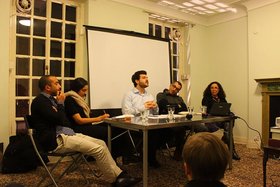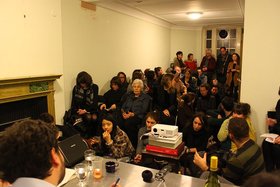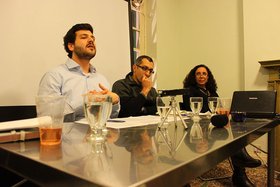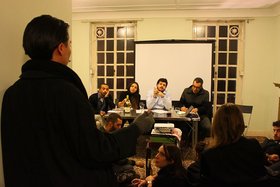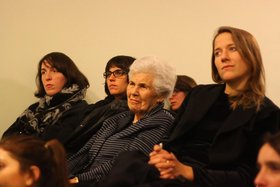News
Is Artists' Independence Being Subsumed by Politics?
Notes from a roundtable discussion on the state of the arts in Egypt
How can an arts agency engage or intervene with the politics of conflict and post-conflict situations? This is a question that I have wrestled with since I was first introduced to Culture+Conflict's mission during an informal conversation in 2010. The question of whether it 'should' or 'could' connect with such spheres was an initial reaction. My concern was that such a platform would always be perceived as polemical, attempting to bridge insurmountable cultural gaps between peripheral communities and the 'centre' – that centre being the UK.
I was resolute that the 'NGO spirit' of giving 'voice' to silenced cultural producers sat at an oppositional end of the spectrum from artists and their desire for fundamental artistic freedom. Indeed, we have seen the influence of organisations with an NGO spirit driving artistic scenes in Ramallah, Cairo and Beirut – collectively fashioning a top-down system for artistic production. Two recent examples include the Arab Fund For Art and Culture and the Foundation for Art Initiatives, who after the kick-off of the 2011 Arab Uprisings, launched funding streams dedicated to supporting cultural output by artists and curators 'affected' by the 'revolution', or alternatively, those who were interested in developing new work influenced by the current socio-political condition.
The prescriptive didacticism of such frameworks, one can argue, functions counter-intuitively. Artistic practice becomes warped, quickly responding to meet the demands of a public or institutional desire. The space and place of art is no longer fluid and contemplative, but rushed to meet market trends, akin to any other form of capitalist production, i.e. industrial design or building projects by 'star' architects. One must forgive my naïve expectations of art's potential function, but I do believe that in tumultuous conflict and post-conflict situations, where formal arts education is often corrupt - that artistic freedom necessitates the liberty to develop art freely from the constraints of competing marketplace demands.
What then was the potential function of Culture+Conflict? Could it operate as a forum for discursive discussion and thinking on the issue of 'culture' as opposed to the sexy fetish of conflict? Upon receiving an invitation to respond to the specific context of the current Egyptian cultural scene, I decided I wanted to wrestle with the problematic tensions that an organisation going by the moniker of Culture+Conflict would have to work through.
Up to this point, too much discussion has revolved around what Sarah Rifky has called the season of 'endless hope' and 'new dawns'. This has subsequently created binary positions of 'us' and 'them' and also an over-suspicion towards a certain critique and theorisation of the post-uprising condition amongst Egyptians. Instead of resisting these polemics, I decided that I would construct a public session that would function in the manner of a 'working group' or 'think tank'. Entitled, 'Is Artists' Independence Being Subsumed by Politics?', this was a forum of different 'actors' operating in distinct spheres, coming together to reflect on a shared agenda. Collectively we exchanged ideas about the way that contemporary culture is presented, mediated, distanciated, nurtured, annihilated, re-articulated, appropriated, dissolved and constructed in contemporary Egyptian society.
On the evening, I was joined by photographer, Ahmad Hosni, academic, Dr Dalia Said Mostafa, writer and curator, Daniella Rose King and the artist, Mahmoud Khaled. Our conversations led us to observations, which sought to complicate existing questions we had each been working through individually.
'Has the politics of uprising shifted the manner in which contemporary artistic practice is shaped, appropriated, interpreted, and shared in Egypt?'
This felt like the most obvious question worth asking, but it was perhaps the most complex for the group. All of the contributors were consciously aware that there is a fear that cultural managers could use the 'Spring' as a catch-all box for cultural production - promoting a singularly didactic view of an 'art scene'. Mahmoud Khaled argued that artists in Egypt have historically been used as instruments for cultural brokers, curators and funding bodies to illustrate politically aligned agendas. Ahmad Hosni seemed to echo this critique by emphasising that many 'non-political' artists have had their work appropriated since the Egyptian revolution of 2011. Pressed to give examples, Hosni used the oft-cited case of the martyred Egyptian media artist, Ahmed Basiony, who was murdered on the 28th January 2011, during the early days of the Egyptian uprisings. The now infamous case of Basiony, who went on to represent Egypt in the Venice Biennale in a presentation that awkwardly juxtaposed performance documentation and raw protest footage, luckily did not hold the grip on our conversation.
Rather, it became apparent quite quickly that the panel was grappling with issues of genre definition. Questions of art soon gave way to discussion of how political situations were bringing amateurism to the forefront of rigorous discourse. It was noted, for example, that the rise of graffiti as an activist tool was being misrepresented as an arts movement. Mahmoud Khaled and Daniella Rose King were quick to argue that graffiti's agency is derived from its immediacy - to function as either a form of political intervention or documentation. Speaking of public graffiti in the same breath as Egypt's contemporary art scene, it was suggested, stripped graffiti of its intent and likewise disavowed the skill, training and education required in the formation of a contemporary art practice. Mostafa was keen to emphasise how our convoluted rhetoric should not take away from the fact that the revolution was able to bring artists, filmmakers, musicians, literary figures and everyday people together in the construction of one joint narrative – a collective and creative struggle for freedom.
Culture+Conflict Co-Director Jemima Montagu followed this up with a caution against the snobbery of 'the art world', whose exclusionary language Montagu seemed to suggest, could exclude more cursory and organic forms of creative practice from burgeoning. This trajectory descended into questions of aesthetics. Did the recent Egyptian conflict give rise to a new visual trend? Has the role of web 2.0 media as a socialising force also affected the formal qualities of cultural output? In Ibraaz Platform 004, Sheyma Buali, among others, discusses how the formal aspects of visual culture over the last two years have been heavily focused on the recycling of raw materials as opposed to the high-production value gloss that pre-dated it. Buali is speaking of more than mere appropriation here, but about how a 'raw' aesthetic is being dislocated and glamorised – making its way into commercial galleries in the UK as a form of fetishism. She subsequently argues that the very exaltation of this aesthetic fuels the public's desire for a visual culture that is raw, live and un-edited; akin to a 24 hour TV news channel or an Internet RSS feed.
Akram Zaatari and Maha Maamoun are two significant artists who have utilised the DIY aesthetic of YouTube and Google Video to produce nuanced work, yet on a polar end of the spectrum, we find visual artists like Nermine Hammam, filmmakers such as Yousry Nasrallah and Ibrahim El Batout, among numerous others, who one can argue are hijacking the narrative of conflict to their advantage - churning output that is either purely opportunistic or sensational. I have recently discussed how El Batout's representation - and indeed psychological validation - of the Egyptian conflict in his latest feature film, Winter of Discontent (2012), plays into all of the generic archetypes of Arabs as crude, barbaric and oppressed. The same can be said of legendary filmmaker Yousry Nasrallah's motion picture, After the Battle (2011) or the haphazardly assembled multi-authored long-form release, 18 Days (2011), all of which diffused the same rudimentary narrative of struggle.
Frustratingly, one was left asking, where were the sedimentary questions within these works? Could one argue that creators were not being offered the space to breathe and create work that could engage the viewer either conceptually, theoretically, or formally? From the audience, artist, researcher, writer, and cultural practitioner, Nadia Christidi, was quick to point out that we should not disregard the opportunism of artists, curators, filmmakers and producers who have been keen to capitalise on the renewed sense of interest developed during this particular moment. Indeed, the blame – if we were to attribute it – cannot only sit with the institutions in the east and west, but with those who leap at the opportunities presented by such conditions. Certainly, the countless projects such as After Tahrir at the American University in Cairo, The Road to Tahrir at the Egyptian Museum of Modern Art, A Night in Tahrir Square at the Barbican, London, Tahrir Spirit at the Goethe Institute Cairo, and Messages from Tahrir also at the American University in Cairo, all required that cultural practitioners contributed to said narratives, nebulous as those narratives and discourses may be.
Still, the working group was in unison on issues of monumental utopianism. We all agreed that sites such as Tahrir Square, for instance, should not be exalted. Mostafa followed this on by arguing that when a site becomes a beacon for an ideological stance or cause, it lends itself to being commoditised. Mostafa used the example of the merchandising stalls that sought to take over Tahrir after former President Hosni Mubarak stepped down – an approach that has undoubtedly been perpetuated by the arts sector. For example, in 2011, commercial gallerist Reedah El-Saie, speaking on the eve of the inaugural neo-colonial project that was the Shubbak Festival in London, noted that:
'Now there is an appetite to understand to the context of the uprising, and there's a real flourishing of work that's more edgy'.
What is 'edgy' within this context is never revealed, yet one assumes that El-Saie is referring to work that is critical of interior 'state regimes' (i.e. self reflectively critical), while still being aesthetically pleasing enough to sell, if the portfolio of her gallery, MICA, is anything to go by.
As we hurtled to the end of our free flowing conversation, Montagu emphasised that there was a potential discrepancy in the notion of the un-tainted artistic practice. She went onto discuss how the artists she had collaborated with in Afghanistan, more often than not, tended to create work that could be deemed politically representational. This comment, however, prompted a distinct delineation between context, subject and form. Arguably, an artist or cultural producer will always be affected by the context by which she or he lives. Yet, the means by which this context is articulated need not necessarily be through responsive and didactic cultural frameworks. I often use the case of the artist Emily Jacir to elucidate this case. Jacir, for example, is an artist whose work is undoubtedly led by a conceptual approach. And although the context is inevitably politicised by its rootedness within the artist's native Palestinian context, her work is neither illustrative nor representative of the kind of didactic socio-politics that is currently being associated with the contemporary post-Arab Spring canon of visual culture.
Mahmoud Khaled followed on from this by asserting that these issues are ones that he has been grappling with for his entire career, expressing frustration with the current curatorial frameworks for Egyptian artists in the UK. Still, Khaled did not seek to disavow politics. 'Everything we do is political', he argued. Rather, he insisted that artists had a right to protection. 'What are we trying to protect?' I queried. The freedom to create work independently and of our own free will, he suggested. Some of our audience asked if this 'protection' would infringe on the audience's liberty to express and engage as cultural actors.
Who has the right to speak? And who is entitled to drive the conversation? Irresolutely, we all agreed that 'the right' belongs to everyone who wishes to take an educated role within this dialogue. Yet one's right to speak should not infringe, re-frame, or indeed, subsume, the plurality inherent within the various conversations, which may only take place on the periphery.
This article is jointly commissioned and published by Culture+Conflict: www.cultureandconflict.org.uk

